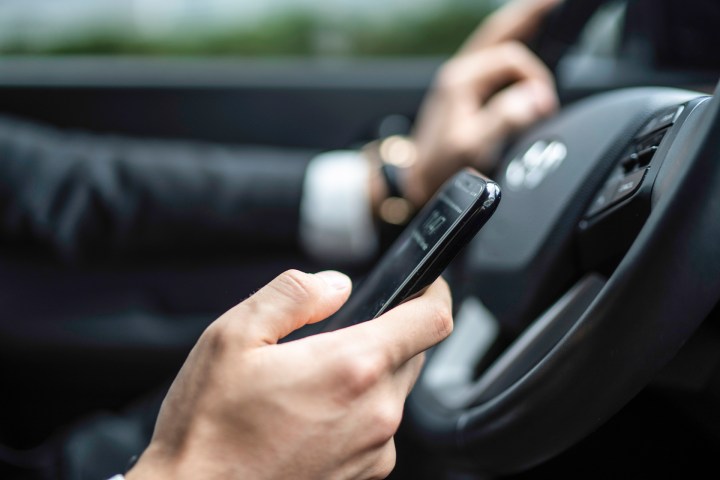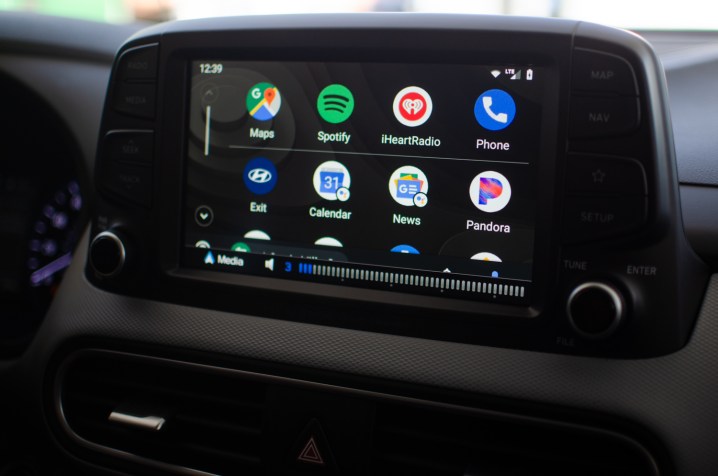
Most of us know that using a phone while driving can kill us or someone else — but it might come as a surprise that the technologies in our vehicles meant to curb phone use can be just as distracting.
A new Multi-National Distracted Driving Study by Liberty Mutual Insurance outlines the frighteningly unsurprising numbers behind distracted and aggressive driving habits in different age groups from the United States and Western Europe. We got our hands on the results a few days early and talked to Mike Sample, the company’s Safe Driving Expert, to understand a career professional’s view on how we’re distracted and what to do about it.
Technology to The Rescue? Not Quite
Nearly every automaker has some level of hands-free tech in its vehicles, at least as optional equipment. Most even have advanced smartphone-projection capabilities like Apple CarPlay and Android Auto that put apps and other functions at eye-level in the vehicle’s infotainment screen. We’re told that these features make us safer; we’re told that they keep us from looking at our phones with eyes off the road.

The reality according to Sample is that anything drawing our attention away from driving is a hazard. He says that hands-free tech gives us the incorrect perception that we’re able to multitask and still be good drivers. Glancing away from the road and dedicating brain power to operating a screen – even through voice commands – is a cognitive distraction that pulls attention away from the task at hand (hint: It’s driving).
Driving Safely
As for running late and multitasking? “Drivers need to keep their heads up to see what others are doing around them. If you can plan ahead and leave the house on time, do so. Reduce driver stress, allow them to get where they need to be. Try not to speed and make erratic decisions,” Sample said.
The old lady next door isn’t just keeping an eye on the neighborhood. She’s also judging you while you drive.
Asked for his final word on driving safely, Sample said “the most important task being done is driving. The phone is a great piece of technology but having it in-hand takes away from that primary task. We (Liberty Mutual) recognize that phone use is rampant in the U.S., because 86 percent of millennial drivers say they use it.”
He went on to say that the high rates of in-vehicle phone use have led us to a point of it no longer being taboo behavior, and that it shouldn’t be accepted as a new normal.
The Study
The study is broken into age groups and geographic locations. Millennials, Gen-Xers, and Boomers were polled on their rates of distracted driving and how they perceived themselves against other drivers. Here’s how the results shook out:
It turns out the old lady next door isn’t just keeping an eye on the neighborhood. She’s also judging you while you drive. The study shows that Boomers everywhere tend to notice bad behaviors in other drivers more than any other age group. So, while she’s just as likely to be texting her bingo crew while at a stoplight as you are to be Snapchatting, she’ll see you way before you see her.
Boomers are also less likely to acknowledge mobile phone use as a problem. In their study responses, they admit knowing that phones use is growing in general but haven’t yet made a connection between use and abuse.
Nearly 90 percent of Gen-X and 91 percent of Boomer Europeans blamed lateness on factors out of their control.
Perhaps least surprising and most affirming of the stereotypes, a higher rate of millennials than any other age group admits to using their phones while driving – 86 percent. They’re also most likely to have the phone out in a visible location, and their rates of doing things like using social media and browsing the internet while driving are higher than the other ages surveyed.
Location Matters
Despite the fact that 98 percent of people interviewed for the study claim to be safe drivers, nearly half (47%) of the Americans say they regularly engage in dangerous driving behaviors. Europeans, in general, are safer drivers – or at least they say they are. Only 39 percent of drivers in Western Europe claim to engage in dangerous driving habits.
Mobile phone use is by far the most prominent distraction noted by everyone in the survey.
Running late is identified as major source of drivers’ irresponsible behaviors and is one that is called out in the survey as making bad habits worse. Why is everyone running behind? The short, depressing story is that there appears to be a lot of unexpected traffic no matter where you are in the world.
Being late leads people to speed, blow yellow lights, roll through stop signs, and multi-task at higher rates than they normally would.
Two-thirds of the Western Europeans and over half of the Americans surveyed called out unexpected traffic as the cause of their lateness. Americans were more likely to admit that they were the reason for their lateness – nearly 90 percent of Gen-X and 91 percent of Boomer Europeans blamed factors out of their control (compared to 82 and 85 percent of Americans, respectively).
Phone Use
The majority of people that responded to the study say they notice other drivers’ bad behaviors, but a significantly smaller number of respondents admit to the actions themselves. People admit to all sorts of distractions in their cars, from using the in-vehicle touchscreen to loud children in the back seat, but mobile phone use is by far the most prominent distraction noted by everyone in the survey.
Again, with millennials, the rates of using the phone while driving are higher than the other age groups, but nearly two-thirds of all the ages from Western Europe and just over two-thirds of all Americans say they’ve used their phones while behind the wheel. Everyone sees red lights and short pauses as an opportunity to use their phones, especially the older generations, though Americans are more likely to tap out an email or text while stopped than their European counterparts.
Nearly all respondents answered one question the same way: Nine out of ten people said that their phones are a possible visual or auditory distraction. The study unsurprisingly shows that, if a mobile phone is available, the driver is much more likely to use it. Knowing that, Sample’s words ring true: The best way to curb phone use is to put it away.
Editors' Recommendations
- This $3 USB adapter fixed all of my Apple CarPlay connection problems
- Amazon Music now has a car mode, but don’t use it while driving
- How tech is making trucks comfier, smoother, and better for everyday drivers
- The car insurance penalty for distracted driving rose nearly 10,000% this decade





